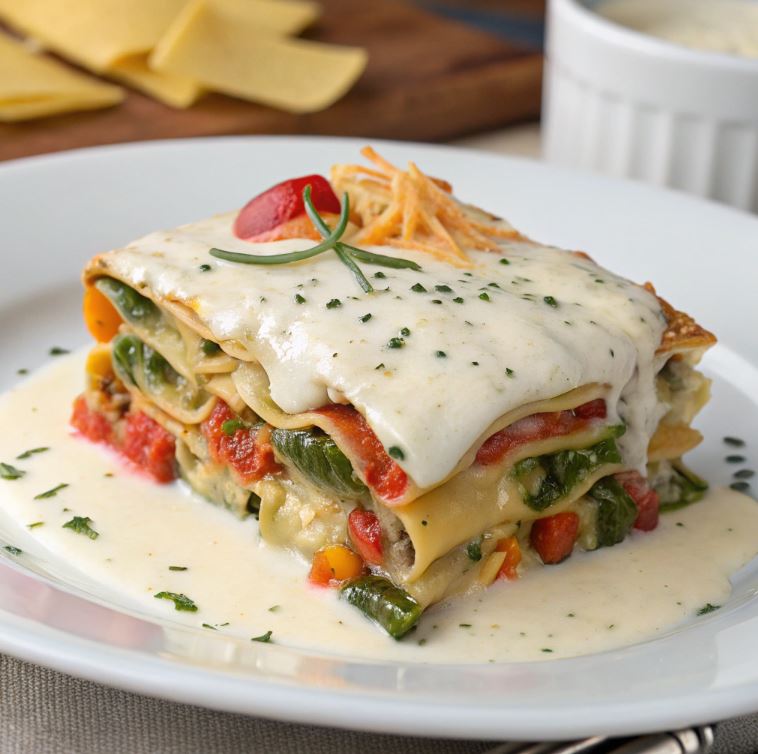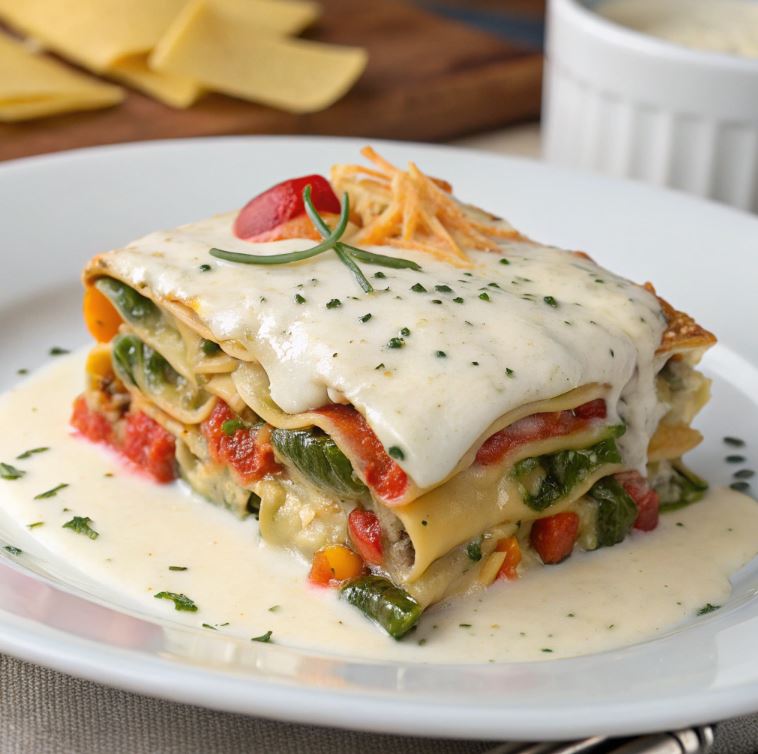Vegetable lasagna with white sauce is a comforting and satisfying dish that brings together layers of tender pasta, a medley of fresh vegetables, and a rich, creamy béchamel sauce. Unlike traditional lasagna made with tomato-based marinara, this version offers a smooth and velvety texture that complements the natural sweetness of roasted vegetables.

This dish is perfect for vegetarians and those who prefer a milder, more delicate flavor. With the right combination of ingredients, this recipe can be both hearty and nutritious. Whether served for a cozy family dinner or a special occasion, this recipe is a crowd-pleaser.
By following a few essential cooking techniques, you can achieve a perfectly balanced lasagna with layers that hold together beautifully. From choosing the best vegetables to assembling the dish with precision, every step contributes to a delicious, creamy masterpiece.
History and Origins of Vegetable Lasagna with White Sauce
The origins of vegetable lasagna with white sauce trace back to Italian cuisine, where pasta, cheese, and sauce are essential elements. Traditional lasagna recipes date back to ancient Rome, with early versions using layers of pasta sheets and a simple sauce. Over time, different regions of Italy developed their own variations, incorporating local ingredients and flavors.
The concept of this recipe likely emerged as a lighter alternative to the classic tomato-based lasagna. The use of béchamel sauce, a staple in French and Italian cooking, provides a creamy texture that pairs well with vegetables like spinach, zucchini, and mushrooms.
Today, this dish has gained popularity worldwide, with chefs and home cooks experimenting with various vegetables, cheeses, and seasonings to create unique versions. Despite its adaptations, the essence of vegetable lasagna with white sauce remains rooted in the comforting layers of pasta and rich, creamy sauce.
Vegetable Lasagna with White Sauce All Over the World
While vegetable lasagna with white sauce originates from Italian cuisine, different cultures have embraced and adapted it to suit regional preferences.
- Italy: The classic version includes béchamel sauce, ricotta cheese, and vegetables like spinach and mushrooms, often layered with fresh lasagna sheets.
- France: French versions incorporate Gruyère cheese and a thicker béchamel for a richer flavor.
- United States: American adaptations often include extra cheese varieties like mozzarella and Parmesan, along with a wider range of vegetables such as bell peppers and carrots.
- India: Spices like cumin and garam masala are added to the vegetables, giving the dish a bold, aromatic twist.
- Middle East: Some versions use roasted eggplant and feta cheese for a Mediterranean-inspired take.
Each variation brings a unique flavor profile, proving that this recipe is a versatile dish enjoyed across cultures.
Detailed Ingredients for Vegetable Lasagna with White Sauce
A well-balanced vegetable lasagna relies on high-quality ingredients that enhance both flavor and texture.

Essential Ingredients:
- Lasagna Sheets: Fresh or dried pasta, preferably no-boil for convenience.
- White Sauce (Béchamel): Made from butter, flour, milk, and nutmeg for a smooth, creamy base.
- Cheese: A combination of ricotta, mozzarella, and Parmesan for a rich, cheesy texture.
- Vegetables: Common choices include spinach, zucchini, mushrooms, bell peppers, and onions.
- Garlic and Herbs: Fresh garlic, basil, oregano, and thyme enhance the overall flavor.
- Olive Oil: Used for sautéing vegetables to bring out their natural sweetness.
- Salt and Pepper: Essential seasonings to balance the flavors.
Optional Additions:
- Nuts: Toasted pine nuts or walnuts for added texture.
- Protein: Cottage cheese or tofu for extra protein.
- Truffle Oil: A drizzle for an upscale touch.
Selecting fresh, high-quality ingredients is key to making a flavorful and satisfying vegetable lasagna.
Step-by-Step Instructions
1. Prepare the White Sauce:
- Melt butter in a saucepan over medium heat.
- Whisk in flour and cook for 1-2 minutes until lightly golden.
- Gradually add warm milk, whisking continuously to avoid lumps.
- Season with salt, pepper, and a pinch of nutmeg.
- Simmer until the sauce thickens, then remove from heat.
2. Cook the Vegetables:
- Heat olive oil in a large pan.
- Sauté garlic, onions, and bell peppers until softened.
- Add mushrooms and zucchini, cooking until tender.
- Stir in spinach and cook until wilted.
- Season with salt, pepper, and herbs.
3. Assemble the Lasagna:
- Spread a thin layer of white sauce in a baking dish.
- Add a layer of lasagna sheets.
- Spoon over sautéed vegetables and a layer of ricotta cheese.
- Repeat the layers, finishing with white sauce and shredded mozzarella.
4. Bake and Serve:
- Cover with foil and bake at 375°F (190°C) for 30 minutes.
- Remove foil and bake for another 10 minutes until golden brown.
- Let rest for 10 minutes before slicing and serving.
Tips for Perfect Vegetable Lasagna with White Sauce
- Use No-Boil Noodles: Saves time and absorbs flavors better.
- Let It Rest: Allow the lasagna to sit before slicing for clean layers.
- Roast Vegetables First: Enhances natural sweetness and prevents excess moisture.
- Balance Cheese and Sauce: Too much sauce can make the dish soggy, while too little can make it dry.
Following these techniques ensures the best results for vegetable lasagna.
Health Benefits of Vegetable Lasagna with White Sauce
- Rich in Fiber: Loaded with vegetables that promote digestion.
- High in Calcium: Cheese and milk provide essential nutrients for bone health.
- Balanced Carbs and Protein: The pasta and cheese combination supports energy levels.
- Contains Essential Vitamins: Spinach, mushrooms, and bell peppers supply vitamins A, C, and K.
A well-prepared vegetable lasagna offers a nutritious and delicious meal.
Diet Information
Vegetable lasagna with white sauce can fit into various diets depending on ingredient choices. While traditional recipes use dairy-based béchamel and cheese, modifications can make it suitable for different dietary needs.
- Vegetarian-Friendly: This dish is naturally meat-free, making it a great choice for vegetarians.
- Gluten-Free: Use gluten-free lasagna sheets and replace regular flour in the white sauce with cornstarch or a gluten-free alternative.
- Low-Carb: Swap pasta sheets for layers of grilled zucchini or eggplant to reduce carbohydrate content.
- Vegan: Replace dairy milk with plant-based alternatives like almond or oat milk and use nutritional yeast or vegan cheese for flavor.
- High-Protein: Adding cottage cheese or tofu boosts protein content.
By adjusting ingredients, this recipe can be customized to fit different dietary preferences while maintaining its rich, creamy taste.
Making Vegetable Lasagna with White Sauce Kid-Friendly
For children, vegetable lasagna with white sauce can be adapted to make it more appealing while still providing essential nutrients. Since kids can be selective about vegetables, subtle modifications can enhance the dish’s appeal.
- Finely Chop Vegetables: Blending or dicing vegetables into smaller pieces makes them less noticeable.
- Add a Mild Cheese Blend: Using mild mozzarella instead of sharp cheeses makes the taste more kid-friendly.
- Use Whole Wheat Pasta: Provides more fiber and nutrients while keeping the familiar pasta texture.
- Avoid Overly Strong Flavors: Keep seasoning mild to suit young palates.
- Let Kids Help Assemble: Involving children in layering the lasagna makes them more likely to enjoy eating it.
With a few adjustments, vegetable lasagna becomes a kid-approved meal that’s both nutritious and delicious.
Vegetable Lasagna with White Sauce Serving Suggestions and Pairings
A well-prepared vegetable lasagna with white sauce pairs beautifully with a variety of side dishes, enhancing the overall dining experience.
Recommended Side Dishes:
- Garlic Bread: Crispy, buttery garlic bread complements the creamy lasagna.
- Fresh Green Salad: A light salad with vinaigrette balances the richness of the dish.
- Roasted Vegetables: Caramelized Brussels sprouts or asparagus add extra flavor and texture.
- Tomato Basil Soup: A warm, tangy soup provides contrast to the creamy lasagna.
Best Wine Pairings:
- White Wine: Chardonnay or Sauvignon Blanc complements the béchamel sauce.
- Light Red Wine: Pinot Noir pairs well with the mild flavors of the lasagna.
Pairing this recipe with the right sides and beverages enhances its flavors and makes for a complete meal.
Common Mistakes to Avoid
Making vegetable lasagna with white sauce seems simple, but a few common mistakes can affect the final dish.
- Using Watery Vegetables: Failing to sauté or roast vegetables before layering can result in a runny lasagna.
- Skipping the Resting Time: Cutting the lasagna too soon causes layers to slide apart.
- Overloading with Sauce: Too much white sauce can make the dish too heavy and soggy.
- Not Cooking Pasta Properly: Overcooked noodles become mushy, while undercooked pasta stays too firm.
- Using Low-Quality Cheese: Choosing fresh, high-quality cheese ensures a creamy texture and rich taste.
Avoiding these pitfalls guarantees a well-structured, delicious vegetable lasagna.
Vegetable Lasagna with White Sauce Variations
While the classic version is a favorite, there are plenty of ways to modify vegetable lasagna with white sauce to suit different tastes.
- Mediterranean Style: Add olives, feta cheese, and roasted red peppers for a bold, tangy twist.
- Mushroom Lover’s Edition: Use a mix of wild mushrooms like portobello, shiitake, and cremini for a deeper flavor.
- Spicy Kick: Add red pepper flakes or jalapeños for a little heat.
- Protein Boost: Mix in ricotta blended with mashed tofu for added protein.
- Nutty Flavor: Sprinkle toasted pine nuts or walnuts between layers for extra crunch.
Experimenting with different variations keeps this recipe exciting and customizable.
Storage and Reheating Tips
Proper storage and reheating techniques help maintain the quality of vegetable lasagna with white sauce.
Storage:
- Refrigeration: Store leftovers in an airtight container for up to 4 days.
- Freezing: Wrap individual portions in plastic wrap and foil, then freeze for up to 3 months.
Reheating:
- Oven: Bake at 350°F (175°C) for 20 minutes until heated through.
- Microwave: Cover with a damp paper towel and heat in 30-second intervals.
- Stovetop: Reheat in a covered skillet over low heat with a splash of milk to prevent drying out.
Following these methods ensures vegetable lasagna with white sauce remains just as delicious as when freshly made.
FAQ
What vegetables work best in vegetable lasagna with white sauce?
Zucchini, spinach, mushrooms, bell peppers, and onions are excellent choices as they complement the creamy sauce without becoming too watery.
Can I make vegetable lasagna with white sauce ahead of time?
Yes! Assemble the lasagna and refrigerate it overnight before baking. This allows flavors to develop and makes preparation more convenient.
How do I prevent vegetable lasagna with white sauce from becoming watery?
Sauté vegetables before layering and avoid using too much sauce. Letting the lasagna rest before slicing also helps absorb excess moisture.
Can I make vegetable lasagna with white sauce without dairy?
Absolutely! Use plant-based milk, vegan butter, and dairy-free cheese alternatives for a fully vegan version.
What’s the best cheese for vegetable lasagna with white sauce?
A combination of ricotta, mozzarella, and Parmesan provides the best flavor and texture. For a richer taste, Gruyère or Fontina can also be used.
Conclusion
Vegetable lasagna with white sauce is a versatile and satisfying dish that brings together creamy béchamel, tender pasta, and fresh vegetables in every bite. Whether making it for a family dinner, meal prep, or a special occasion, this dish delivers both comfort and flavor.
By choosing the right ingredients, avoiding common mistakes, and following proper cooking techniques, you can create a restaurant-quality lasagna at home. With countless variations, this dish can be tailored to suit any dietary preference.
Enjoying a well-prepared vegetable lasagna with white sauce guarantees a wholesome, flavorful meal that will quickly become a household favorite.

